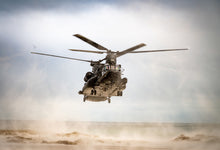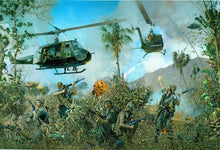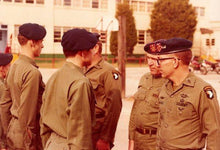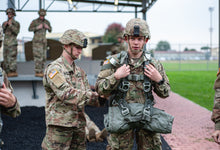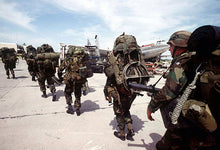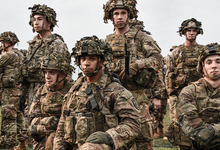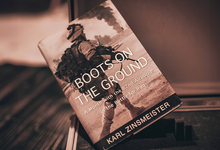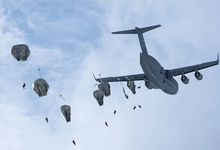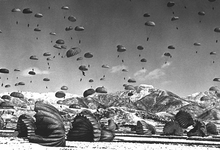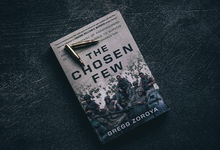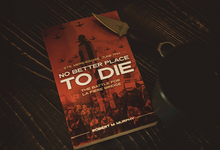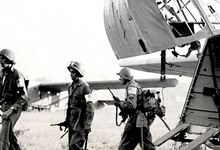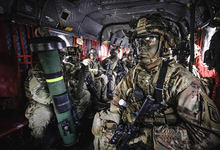Under the cover of the dark, before sunrise, on Feb. 23rd, 1945, the U.S. 11th Airborne paratroopers waited to launch a daring surprise attack and rescue on the Los Banos Japanese war camp in conjunction with Filipino guerillas.
2,148 civilian prisoners at the camp, most of them American and European men, women and children, were the target of the mission.
The raid would take place deep in enemy territory and was planned long before the arrival of liberation forces on the island of Luzon – a joint effort between the Filipino guerillas and U.S. intelligence operations.
Other than 11 Navy nurses and a few servicemen, the majority of the internees were bankers, businessmen, teachers, and missionaries of American, Australian, British, Canadian, Dutch and other nationalities.
The prisoners were being brutally treated and were starving by early 1945, under the supervision of the second in command at the camp, Warrant Officer Sadaaki Konishi.
Konishi became notorious for his cruel punishments. He would purposely withhold salt from prisoners to torture them with cramps.
He even dumped a truck full of fruit on the asphalt behind the camp and challenged the prisoners to retrieve it, but in the vicious heat exceeding 110F, it all quickly rotted and was beyond edible.
In general, the war had been going poorly for the Japanese at that point and the guards had became increasingly brutal to any Western prisoners.
Diseases were spreading throughout the camp including malaria, tuberculosis and dysentery. Medical supplies and treatments were virtually non-existent.
General MacArthur had seen the conditions of recently liberated camps and was appalled at the conditions. POWs were being starved, treated badly and mass executions had begun.
He knew of the urgency to rescue the prisoners at Los Banos in early February of 1945. However, his ground forces at that time were still weeks from the camp as they were fighting deeply entrenched Japanese defenders in the Battle of Manila.
He ordered the 11th Airborne to liberate Los Banos on Feb. 12th. They would have the potential to access behind enemy lines and execute the raid against the relatively sparsely defended camp ahead of Macarthur’s forces arriving.
In the days prior to the rescue, the POWs at Los Banos were desperate to get the word out about their condition.
For weeks they had seen Allied aircraft flying to and from the Battle of Manila and had also heard that Allied forces had landed in Luzon from a smuggled radio.
Despite the prisoners’ excitement, they knew that word had to get out about their condition as quickly as possible, as they were facing the real possibility of execution by the Japanese guards.
Three men were sent by the camp’s executive committee to warn the Allies on a dangerous mission with a very real possibility of death. Under cover of darkness, they crawled underneath barbed wire and escaped into the jungle without being noticed by the guards.
They luckily encountered a group of guerillas that helped them navigate through the jungle. The journey took them across dense jungles, forests, lakes and rivers for several days to reach the Allies – most of the travel was also at night to avoid detection by patrols.
The escapees finally reached American forces and were able to provide detailed information on the location of the guards, their posts, fences, gun towers, and schedules. This valuable intelligence was used to adjust the plans for the raid and the raid date was moved up by several days.
A particularly valuable bit of information would prove useful for the raid – the guards performed morning calisthenics for 30 minutes at 6:45 a.m. During this time just few guards remained on duty, making it the perfect opportunity for the strike.
By the morning of the 23rd, the guards had been severely restricting water and food from the prisoners and many were in terrible condition. It was time for their rescue or almost certain death.
Mission Plan
The 11th Airborne had arrived in the Southwest Pacific by the middle of 1944 under Maj. Gen. Joseph Swing. On Feb. 3, 1945, Gen. Swing was tasked with rescuing the POWs at Los Banos. Despite the 11th Airborne being entangled in a series of battles south of Manila, Swing ordered a rescue plan to be developed at the earliest possible opportunity.
The 1st Battalion, 511th Parachute Infantry Regiment was the main unit selected to carry out the mission under Major Henry Burgess. On the 18th of February, the group pulled out from the Genko Line, the system of anti-tank defenses and pillboxes south of Manila and proceeded to Paranaque district to regroup for the mission.
On Feb. 20, 1945, conditions became favorable for the raid. Robert Soule’s 188th Glider Infantry Regiment was assigned the daunting task of staving off a counterattack on the main highway; across the San Juan river were some 8,000 to 10,000 Japanese troops commanded by Lt. Gen. Shizuo Yokoyama that could counterattack at any time.
The Plan
The joint U.S.-Filipino guerilla rescue plan was designed as follows:
Phase 1 - The 11th Airborne’s Provisional Reconnaissance Platoon under 1Lt George Skau along with 20 Filipino guerillas would travel behind enemy lines in fishing boats across Laguna Lake and wait two nights before the raid.
Phase 2 - 1st Battalion, B Company, 511th PIR commanded by Lieutenant John Ringler would parachute into a drop zone near the camp, rendezvous with a guerilla unit and neutralize any guards.
Phase 3 - The rest of the 1st Battalion would board the amphibious assault vehicles of the 672nd Amphibian Tractor Battalion under Lt. Col. Joseph W. Gibbs, enter Laguna Bay and head to Mayondon Point about two miles from the camp. From here they would travel overland and head to the camp to arrive shortly after 7:00 to carry the internees back to Mayondon Point for escape.
Phase 4 - The 188th Glider Infantry Regiment and Company C of the 637th Tank Destroyer Battalion along with elements of the 675th and 472nd Field Artillery Battalions would move down Highway 1 and act as a diversionary force against a Japanese counterattack.
Execution
Shortly before 7 a.m., the paratroopers began landing outside of the camp on low flying planes. The starving POWs initially thought the drops were food packages until shots began ringing out all over the camp.
In total, 170 paratroopers from the 11th Airborne and 75 guerillas coordinated a joint strike and surprised the few guards who were at their posts soon after 7 a.m. on Feb 23rd.
The carefully planned raid and perfect timing resulted in the guards being easily overtaken. However time was of the essence because a 10,000 strong Japanese infantry division was as close as 3 hours away.
The POWs were elated but the rescuers were surprised at their frail condition. The prisoners were in no condition to walk long distances, and roads leading out were destroyed by the Japanese, so the best option was an amphibious rescue.
The POWs had to be rescued in groups of 30 on around 5 dozen amphibious tractors called amtracs across the largest lake in the Philippines, the 25 mile long Laguna de Bay.
The 11th Airborne felt the most vulnerable during the time that the amtracs were transporting the first group of POWs and the rest remained behind. An attack from Japanese reinforcements on the beach from behind could prove disastrous.
However, the remaining POWs were transported from the beach — right when Japanese fire and mortar rounds began to escalate and draw closer.
The rescue took about 5 hours in total, and during this time the 11th Airborne protected the POWs at the camp and beach.
The Los Banos raid is considered the most successful airborne raid in all of history. Only 3 Americans were killed and 2 wounded while 2 Filipino guerillas were killed. However, up to 80 Japanese soldiers died in the assault and all the surviving POWs were rescued.
“I doubt that any airborne unit in the world will ever be able to rival the Los Baños prison raid. It is the textbook airborne operation for all ages and all armies.” - General Colin Powell






